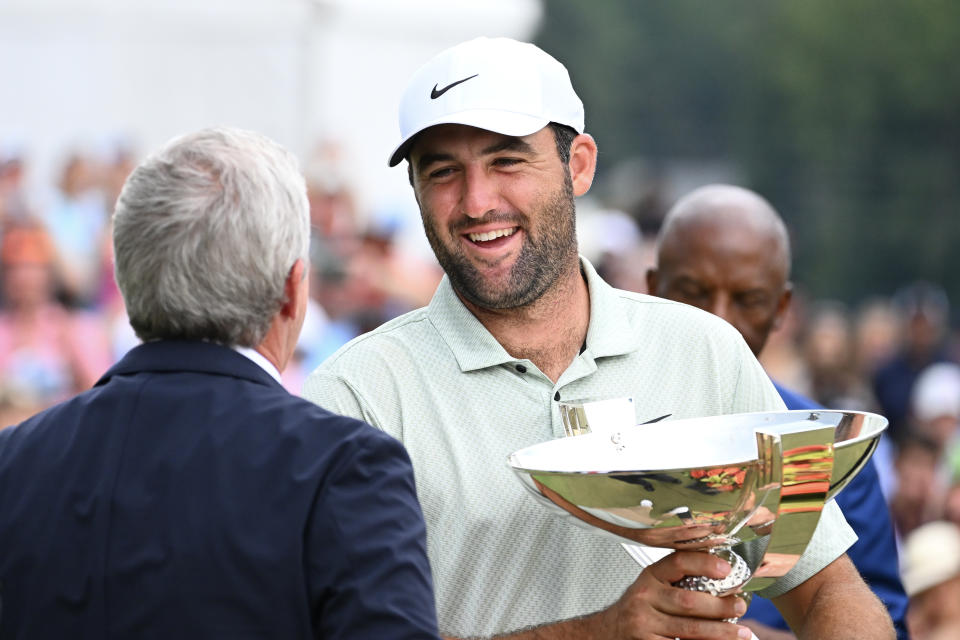Years from now, when we look back at the 2024 golf season, we’ll likely point to Bryson DeChambeau’s 72nd-hole victory over Rory McIlroy at the U.S. Open as the defining moment of the year. Maybe we’ll consider Scottie Scheffler’s tearful gratitude atop the Olympic podium as the most emotional victory of the year. Or maybe we’ll consider Xander Schauffele’s breakthrough wins at both the PGA Championship and the Open Championship as the gutsiest performances of 2024. Who’s to say?
You know what we won’t remember as a season highlight? Scheffler winning the $25 million share of a $100 million FedEx Cup prize at the Tour Championship, or Jon Rahm collecting an $18 million bonus as the 2024 LIV individual champion last weekend at LIV Golf Chicago. Congrats, guys. You took home another eight-figure check. It’s great news for you, your family, your agent, your accountant. And the fans, those still watching, shrug their shoulders.
Golf is not built on paychecks, but on moments, moments when the world’s best compete against each other and against themselves for titles and championships. Money is an incentive for players, not fans – and fans are responding by leaving the professional game in ever-increasing numbers.
Money is also what seemingly keeps the sport divided, resulting in a game in which the sum of the parts is far less than the whole. The PGA Tour season concluded a few weeks ago with the Tour Championship, the LIV season concludes this weekend with its team championship, and the sport appears no closer to unification than it was when the year began.
The PGA Tour and Saudi Arabia’s Public Investment Fund, LIV Golf’s financial backer, announced a surprise “framework agreement” in June 2023. The expectation, realistic or not, was that LIV Golf and the PGA Tour would reunite in some form in the next few years.
But that hasn’t happened. We’ve heard plenty of “optimism” that “negotiations are moving forward” from a host of figures including Tour commissioner Jay Monahan, Tiger Woods and Jordan Spieth, but little in the way of actual progress. Indeed, the most visible outward sign of the state of the negotiations has been the resignation of one of the key figures in getting the deal done in the first place. When Jimmy Dunne resigned from the board in May, citing “no meaningful progress,” that sharply contradicted the “nothing to see here,” all-is-well pronouncements from the players and Tour officials involved in the negotiations.
It’s easy — perhaps too easy — to point to ratings as an indicator of the health of the sport. Ratings are down across the board at virtually every tournament, on both tours. Fewer than 100,000 people tuned in for Rahm’s season-ending singles win last weekend, a figure so staggeringly low that it suggests that if people aren’t tuning into LIV now after three years, they never will.
But the rankings are only as bad as the tournaments they measure; better tournaments will make those numbers change quickly. The bigger concern is that the PGA Tour is losing major sponsors, such as Wells Fargo and Honda. Strategic Sports Group’s massive $1 billion-plus investment will only go so far to replace the departing sponsors; golf is in an unsustainable arms race right now.
Earlier this week, McIlroy suggested that the Justice Department’s potential interest in a merger of LIV and the PGA Tour is holding up negotiations, which is certainly a valid concern. He also noted that there may be some voices — a few loud voices — that aren’t enamored of the idea of reunification.
“I would say maybe half of the LIV players want the deal done, but the other half probably don’t,” McIlroy said. “I would say it’s probably a similar thing on the PGA Tour. Because, like anything, everyone is looking out for their own benefit and their own best interests. You know, some people would benefit if a deal didn’t get done, but obviously some people would benefit if a deal got done.”
He pointed out the difficulty involved when players represent both their interests as players and their interests in the business, noting that these can often be in conflict with each other, i.e. what is good for business may not be good for an individual.
“I think the tours want this to happen,” McIlroy said. “Investors certainly want it to happen because they can see the benefits for themselves. But right now, it’s the Department of Justice and the different opinions of the players.”
There are signs of hope, but they come from outside the negotiating room. Thursday’s PGA Championship codified what had been his de facto The past two years, LIV has practiced and allowed players to play in its events if they qualify. More importantly, McIlroy and Scheffler will play DeChambeau and Brooks Koepka in a televised event later this year, as obvious a sign as any that at least some The players want to reach an agreement.
Are we, to use some golf clichés, within sight of the clubhouse? Or are we on the turn? Or are we still in the equivalent of Thursday afternoon at a tournament, where everything remains unresolved and the conclusion is a long way off?
The game continues, however (on separate tracks) and there is little urgency to reach an agreement. Perhaps appearances are deceiving and perhaps impassive silence is a good negotiating tactic, but it certainly seems as if golf’s power players are gambling (and cashing huge checks) while the sport burns.

